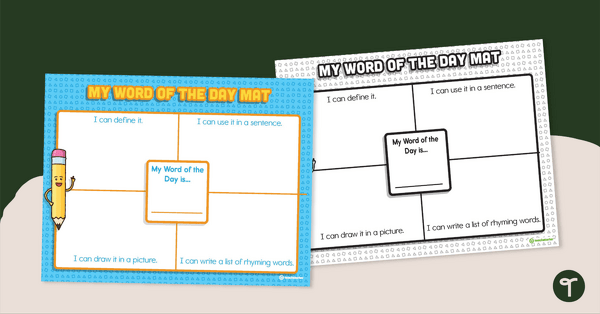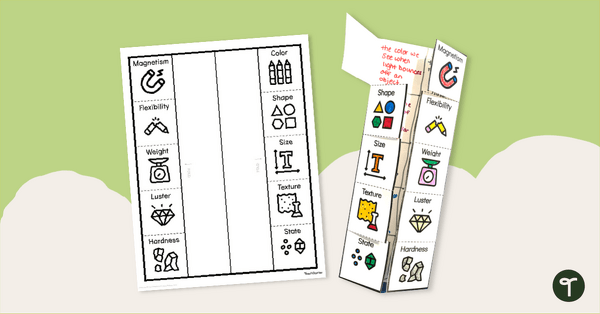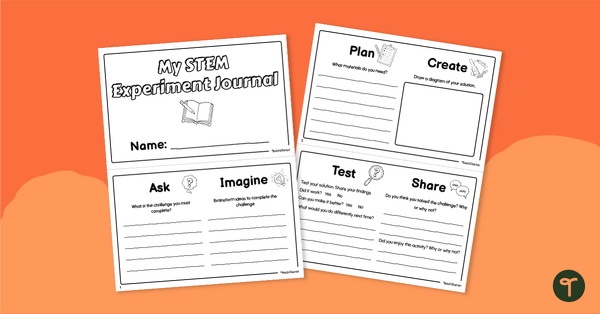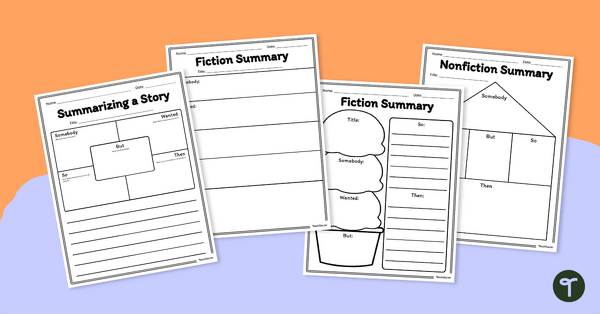Graphic Organizers for Teachers
The blank graphic organizers and printable graphic organizer templates you need most for your elementary classroom are here! Help your students learn to brainstorm ideas and organize information with editable templates you can customize for your classroom.
Carefully designed and curated by our expert teacher team, each of the maps, charts, and diagrams in this collection of templates has been created with the needs of students in mind, and many are already aligned to the curriculum to save you much-needed time in your lesson planning.
You'll find:
- Printable Venn Diagram templates
- T-charts
- KWLs
- Story maps
- Concept diagrams
- Concept maps
- Knowledge maps
- Cognitive organizers
- Advance organizers
- Brainstorming templates
- More classic organizer examples
Not familiar with this teaching tool, or just looking for some fresh ideas for using them in the classroom? Read on for a primer from our teacher team!
What Is a Graphic Organizer?
A graphic organizer, by definition, is a visual guide that breaks down the relationships between ideas, vocabulary, or facts within a learning task. These learning tools scaffold learning for students, allowing them literally construct knowledge. Pretty neat, huh?
Graphic organizers can take the form of templates, charts, or diagrams and be specific to one topic or generalized for use across a range of subjects.
Printing blank templates allows students to use the tool to design their learning, explore relationships between concepts and use their evaluation and judgment skills to determine where information should be added to the organizer.
Types of Graphic Organizer Examples
So what are the different types of graphic organizers in this collection? Let's take a look at some examples and how to use them!
Concept Maps
The term "map" for this graphic organizer refers to the fact that it shares some similarities with a traditional map.
A map of a country or state can visually represent the geographic layout of different places and their relationships. Similarly, a concept map visually represents the connections and relationships between various ideas or concepts. This helps students organize their thoughts and understand the relationships between different topics, as well as helping kids understand the overall structure of a topic.
Venn Diagrams
A Venn diagram is used to show the logical relationships between two or more sets of items. The Venn diagram is named for John Venn, a mathematician, logician, and philosopher known for his work in probability.
Although a classic Venn diagram is made up of overlapping circles, other shapes can be used with this graphic organization tool. And while a Venn Diagram is often made up of just two or three circles, some forms can encompass larger numbers of shapes.
Especially useful in math and ELA classes, a Venn diagram can help students easily analyze similarities and differences between characters, objects or concepts. For example, a student might use a Venn diagram in math to sort and classify numbers or geometric shapes.
Story Maps
A story map is a graphic organizer that can help ELA students understand the elements of a story — concepts such as characters, setting, plot and resolution.
This handy tool gives kids a visual outline of the story's structure and helps students identify key elements and their relationships, plus it helps them track plot progression.
KWL Charts
KWL stands for Know-Want to know-Learned, and charts built around this acronym count as graphic organizers! They're used to activate prior knowledge, guide inquiry-based learning and track learning progress.
The goal is for students to fill in what they already know about a topic, what they want to learn, and what they have learned. This gets kids to engage with the content and ask questions!
Cause and Effect Charts
Typically used in social studies or science, cause and effect charts help students understand the relationship between events or actions.
For example, students can use one of these charts to identify the causes and consequences of a specific event in history or to analyze cause-and-effect relationships in a science experiment.
Flowcharts
Flowcharts use symbols and arrows to represent a sequence of steps or events. This type of organizer tends to be used in subjects like science and math to help kids visualize processes, procedures and problem-solving strategies.
In science, for example, a student might use a flowchart to illustrate the steps of the water cycle. They could use symbols and arrows to represent each stage, starting with "Evaporation," followed by "Condensation," "Precipitation" and "Collection." Arrows would then connect the steps logically, showing the water flow through the cycle.
Mind Maps
Yup, we have yet another kind of map on this list! Mind maps are diagrams that start with a central idea and branch out to represent related concepts or ideas visually.
You can use these organizers for brainstorming, organizing thoughts and making connections between different pieces of information, and they come in handy across a broad range of school subjects.
In writing, for example, a student could use a mind map to generate ideas or outline an essay. Meanwhile, in science class, mind maps can help a student explore different branches of a scientific concept or create visual summaries of key scientific principles.
Comparison Charts
Comparison charts help students analyze similarities and differences between two or more objects, concepts, or ideas. They are used to compare and contrast information, such as characteristics of animals, historical figures or different geographical locations.
Let's say a student needs to compare two animals in science class — an elephant and a giraffe.
They could use a comparison chart with columns for different attributes like "Size," "Habitat," "Diet" and "Physical Features." Under each column, they would then fill in the specific characteristics and compare how elephants and giraffes are different or share similarities.
Timelines
As a graphic organizer, a timeline provides a structured framework for organizing and presenting information visually. Students can see the progression of events over time, making it easier to understand historical developments, story plots or the sequence of steps in a process.
A timeline typically includes a horizontal or vertical line representing a specific timespan. Specific points or intervals are marked along the line to indicate specific events or periods. Events are then labeled and positioned relative to when they happen — this way kids can more easily grasp the order of each event and how long each one lasted.
Problem-Solution Charts
Problem-solution charts help students analyze problems and create potential solutions. They typically include sections for identifying the problem, brainstorming possible solutions and evaluating the best way to move forward.
This organizer can help kids with planning out a project like solving the problem of waste in the cafeteria. They could identify that the garbage can is always full of items that could be recycled, brainstorm ways to address the issue, and come up with a plan to add recycling bins beside the garbage can.
T-Charts
T-Charts are fairly simple graphic organizers.
They divide information into two columns — a line at the top and a line down the center give this organizer its name — and help students compare and contrast information or categorize data into two categories.
Benefits of Graphic Organizer Templates
Should you use this tool in your classroom to support your students' learning goals? We can't tell you that — but just look at the benefits of graphic organizers!
A graphic organizer helps students organize their ideas, drawing out relationships between ideas or concepts and expressing them in a graphic display. These visual representations or guides may also help students to retain information.

Not sure which organizer you and your students need?
Don't worry; this collection of teaching resources has them all covered with resources created by teachers for teachers, including free printables and templates to scaffold learning in social studies, ELA, and beyond.
- Plus Plan

Persuasive Writing Graphic Organizer Pack
Help students gather their thoughts during persuasive writing with this differentiated set of graphic organizers.
- Free Plan

Literary Plot Elements - Graphic Organizer
Familiarize students with finding the 5 elements of plot in a literary text.
- Plus Plan

Opinion Paragraph - OREO Planning Template
Help your students write well constructed opinion paragraphs using the OREO acronym with these planning templates.
- Free Plan

Information Text Graphic Organizers
Get your students to plan and write informational texts with this set of 6 differentiated graphic organizers.
- Free Plan

Narrative Plot Structure - Story Mountain Template
Use a story mountain template to help your students write narrative stories.
- Free Plan

Story Map Graphic Organizer Pack
Download and use a printable Story Map Graphic Organizer to help your students make sense of story elements related to their reading.
- Free Plan

Story Elements Graphic Organizers – Portrait
Encourage your students to write and draw about various story elements with this set of differentiated graphic organizers.
- Free Plan

My Word of the Day Mat
A fun worksheet to use in the classroom when building vocabulary.
- Free Plan

Blank Timeline - Printable Template
Use a printable blank timeline to help your students sequence historical events.
- Free Plan

Note-taking Graphic Organizer
A graphic organizer for students to use when taking notes.
- Plus Plan

Scientific Prediction & Observation Templates (K-2)
Introduce your early learners to scientific inquiry skills with a set of printable Scientific Observation templates.
- Free Plan

Triple Venn Diagram Template
Download a printable Triple Venn Diagram Template to use when comparing and contrasting three topics.
- Free Plan

Cornell Notes Template
Help your students organize their notes with a free Cornell Notes Template.
- Free Plan

5-4-3-2-1 Grounding Exercise – Worksheet
De-escalate your students while in difficult situations with this calming exercise.
- Free Plan

Sensory Chart Graphic Organizer
A graphic organizer for students to use when categorizing sensory details.
- Plus Plan

Hamburger Graphic Organizer
Use this blank hamburger graphic organizer to help students visually outline the key components of a good paragraph.
- Plus Plan

Venn Diagram Graphic Organizer
A blank Venn diagram graphic organizer to use in any subject area.
- Free Plan

Five Finger Summary - Graphic Organizer
A graphic organizer for students to use to summarize a fiction text.
- Plus Plan

Historical Context in Literature Doodle Notes
Support students to explore historical context in literature with this two-page graphic organizer that helps them record key historical details from a piece of literature.
- Plus Plan

Comparing and Contrasting Texts Graphic Organizers
Support students in comparing and contrasting texts with this versatile set of graphic organizers designed to deepen comprehension and enhance classroom discussions.
- Plus Plan

Character Emotions Chart and Worksheets
Explore character emotions in stories using this Character Emotions Chart and matching character Graphic Organizers
- Free Plan

Foldable Graphic Organizer of Matter Properties - 5th & 6th Grade
Introduce your students to observable and measurable properties of matter with a foldable Graphic Organizer of Matter Properties.
- Plus Plan

Printable Journal for STEM Experiments
Use this STEM Experiment journal to organize data and learning with your students when completing STEM experiments.
- Plus Plan

Chemical and Physical Changes in Matter Doodle Notes Template
Use our Chemical and Physical Change Doodle Notes Template to encourage your students to understand more about changes in matter.
- Free Plan

Learning Reflection Templates
When finishing a unit or particular piece of work, have your students show you their understandings on a 3-2-1 Feedback Plan.
- Plus Plan

Summarizing a Story Graphic Organizers
Help students remember the fundamentals of summarizing a story with this set of fun graphic organizers.
- Free Plan

Finding the Main Idea - Graphic Organizer Templates
Teach students how to find the main idea of a text using one of these one-page graphic organizers.
- Free Plan

Subtraction with Regrouping - Printable Math Mat
Explore subtraction with regrouping using a printable subtraction math mat.
- Plus Plan

Causes of The Civil War Timeline Worksheet
Build a chronological timeline for students to visually model the progression of events leading to the American Civil War.
- Free Plan

Why Plant a Tree? Infographic Analysis Activity & Posters
Teach about Arbor Day or Earth Day with an infographic poster and a cloze note-taking worksheet about the importance of trees in our environment.
- Plus Plan

Valentine's Day Opinion Writing - Resource Pack
Write some really “sweet” Valentine’s Day essays with our differentiated Opinion Writing Essay pack.
- Plus Plan

Founding Fathers Compare/Contrast Worksheet
Compare and contrast America’s founding fathers with a set of compare and contrast Venn diagrams for kids.